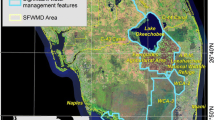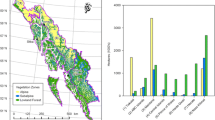Abstract
It is important to understand the vulnerability of the water management system in south Florida and to determine the resilience and robustness of greater Everglades restoration plans under future climate change. The current climate models, at both global and regional scales, are not ready to deliver specific climatic datasets for water resources investigations involving future plans and therefore a scenario based approach was adopted for this first study in restoration planning. We focused on the general implications of potential changes in future temperature and associated changes in evapotranspiration, precipitation, and sea levels at the regional boundary. From these, we developed a set of six climate and sea level scenarios, used them to simulate the hydrologic response of the greater Everglades region including agricultural, urban, and natural areas, and compared the results to those from a base run of current conditions. The scenarios included a 1.5 °C increase in temperature, ±10 % change in precipitation, and a 0.46 m (1.5 feet) increase in sea level for the 50-year planning horizon. The results suggested that, depending on the rainfall and temperature scenario, there would be significant changes in water budgets, ecosystem performance, and in water supply demands met. The increased sea level scenarios also show that the ground water levels would increase significantly with associated implications for flood protection in the urbanized areas of southeastern Florida.








Similar content being viewed by others
References
Abtew W, Obeysekera J, Iricanin N (2011) Pan evaporation and potential evapotranspiration trends in South Florida. Hydrol Process 25:958–969
Bachoon D, Jones RD (1992) Potential rates of methanogenesis in sawgrass marshes with peat and marl soils in the Everglades. Soil Biol Biochem 24(1):21–27
Cook MI, Kobza M (eds) (2011) South Florida Wading Bird Report (17). South Florida Water Management District, West Palm Beach, FL
Cornwell G, Hutchinson EC (1974) An ecological analysis of an Everglades township in southwestern Palm Beach County, Florida. Ecoimpact, Gainesville, FL
Cronin T, Dwyer G, Schwede S, Vann C, Dowsett H (2002) Climate variability from the Florida Bay sedimentary record: possible teleconnections to ENSO, PNA and CNP. Climate Research 19 for PDO
Davis JH (1943) The natural features of southern Florida: especially the vegetation, and the Everglades. Geology Bulletin 25, Florida Geological Survey, Tallahassee, FL
Enfield DB, Mestas-Nuñez AM, Trimble PJ (2001) The atlantic multidecadal oscillation and its relation to rainfall and river flows in the Continental U.S. Geophys Res Lett 28(10):2077–2080. http://www.aoml.noaa.gov/phod/docs/enfield/enfield_etal2001.pdf
Fernald EA, Purdum ED (1998) Water resources atlas of Florida. Institute of Science and Public Affairs, Florida State University, Tallahassee, FL
Field CB, Jackson RB, Mooney HA (1995) Stomatal responses to increased CO2: implications from the plan to the global scale. Plant Cell Environ 18:1214–1225
Hargreaves GH, Samani ZA (1982) Estimating potential evapotranspiration. J Irrig Drain Eng ASCE 108(3):225–230
Havens KE, Steinman AD (2014) Ecological responses of a large shallow lake (Okeechobee, Florida) to climate change and potential future hydrologic regimes. Environ Manag. doi:10.1007/s00267-013-0189-3
Heimlich BN, Bloetscher F, Meeroff DE, Murley J (2009) Southeast Florida’s resilient water resources: adaptation to sea level rise and other climate change impacts. Center for Environmental Studies, Florida Atlantic University
Held IM, Soden BJ (2006) Robust responses of the hydrological cycle to global warming. J Clim 19:5686–5699
IPCC (2007) Climate Change 2007: the physical science basis. In: Solomon S, Qin D, Manning M, Chen Z, Marquis M, Averyt KB, Tignor M, Miller HL (eds) Contribution of Working Group I to the Fourth Assessment Report of the Intergovernmental Panel on Climate Change. Cambridge University Press, Cambridge
IPCC (2013) Climate Change 2013: the physical science basis. In: Stocker TF, Qin D, Plattner G-K, Tignor M, Allen SK, Boschung J, Nauels A, Xia Y, Bex V, Midgley PM (eds) Contribution of Working Group I to the Fifth Assessment Report of the Intergovernmental Panel on Climate Change. Cambridge University Press, Cambridge
Irizarry-Ortiz MM, Obeysekera J, Park J, Trimble P, Barnes J, Park-Said W, Gadzinski E (2013) Historical trends in Florida temperature and precipitation. Hydrol Process 27(16):2225–2246
Johnson J (2012) Estimating the vulnerability of everglades peat to combustion. Master’s Thesis, Environmental Sciences Program, Florida Atlantic University
Malone SL, Starr G, Staudhammer CL, Ryan MG (2013) Effects of simulated drought on the carbon balance of Everglades short-hydroperiod marsh. Glob Change Biol. doi:10.1111/gcb.12211
Maurer EP, Brekke L, Pruitt T, Duffy PB (2007) Fine-resolution climate projections enhance regional climate change impact studies. EOS Trans AGU 88(47):504. doi:10.1029/2007EO470006
McVoy CW, Park WA, Obeysekera J, VanArman J, Dreschel TW (2011) Landscapes and hydrology of the pre-drainage Everglades. University Press of Florida, Gainesville
Mearns LO, Gutowski WJ, Jones R, Leung LY, McGinnis S, Nunes AMB, Qian Y (2009) A regional climate change assessment program for North America. EOS 90(36):311–312
Milly PCD, Bettencourt J, Falkenmark M, Hirsch RM, Kundezewicz ZW, Lettenmaier DP, Stouffer RJ (2008) Stationarity is dead-Whither water management. Science 319:573–574. doi:10.1126/science.1151915
Mitsch WJ, Gosselink JG (1993) Wetlands. Wiley, New York
Moss R, Edmonds JA, Hibbard KA, Manning MR, Rose SK, van Vuuren DP, Carter T, Emori S, Kainuma M, Kram T, Meehl GA, Mitchell GFB, Nakicenovic N, Riahi K, Smith SJ, Stouffer RJ, Thomson AM, Weyant JP, Wilbanks TJ (2010) The next generation of scenarios for climate change research and assessment. Nature 463:747–756. doi:10.1038/nature08823
Neelin JD, Munnich M, Su H, Meyerson JE, Holloway CE (2006) Tropical drying trends in global warming models and observations. PNAS 103(16):6110–6115
Nungesser MK (2011) Reading the landscape: temporal and spatial changes in a patterned peatland. Wetl Ecol Manag. doi:10.1007/s11273-011-9229-z
Nungesser M, Saunders C, Coronado-Molina C, Obeysekera J, Johnson J, McVoy C, Benscoter B (in press) Potential effects of climate change on Florida’s Everglades. Environ Manag
Obeysekera J, Irizarry M, Park J, Barnes J, Dessalegne T (2011a) climate change and its implication for water resources management in South Florida”. J Stoch Environ Res Risk Assess 25(4):495
Obeysekera J, Park J, Irizarry-Ortiz M, Trimble P, Barnes J, VanArman J, Said W, Gadzinski E (2011b) Past and projected trends in climate and sea level for South Florida. Interdepartmental Climate Change Group. South Florida Water Management District, West Palm Beach, FL, Hydrologic and Environmental Systems Modeling Technical Report
Parris A, Bromirski P, Burkett V, Cayan D, Culver M, Hall J, Horton R, Knuuti K, Moss R, Obeysekera J, Sallenger A, Weiss J (2012) Global sea level rise scenarios for the US National Climate Assessment. NOAA Tech Memo OAR CPO-1. 37 pp, December
Robertson WB (1953) A survey of the effects of fire in Everglades National Park. U.S. Dept. of Interior, National Park Service, Everglades National Park, Homestead, FL
Saha K, Saha S, Sadle J, Jiang J, Ross MS, Price RM, Sternberg LSLO, Wendelberger KS (2011) Sea level rise and South Florida coastal forests. Clim Change. doi:10.1007/s10584-011-0082-0
Science Coordinating Team (SCT) (2003) The role of flow in the everglades ridges and slough landscape. Report to the South Florida Ecosystem Restoration Task Force Working Group, West Palm Beach, FL
SFRCC (2011) A Unified Sea Level Rise Projection for Southeast Florida, Southeast Florida Regional Climate Change Compact. http://southeastfloridaclimatecompact.org/pdf/Sea%20Level%20Rise.pdf
South Florida Water Management District (2005) Documentation of the South Florida Water Management Model Version 5.5. South Florida Water Management District, West Palm Beach, FL
South Florida Water Management District (2009) Climate Change and Water Management in South Florida, November 3, 2009, Interdepartmental Climate Change Group, South Florida Water Management District, West Palm Beach, FL. http://my.sfwmd.gov/portal/page/portal/xrepository/sfwmd_repository_pdf/climate_change_and_water_management_in_sflorida_12nov2009.pdf
South Florida Water Management District (2013) Lower East Coast Water Supply Plan Update 2013. South Florida Water Management District, West Palm Beach, FL. http://www.sfwmd.gov/portal/page/portal/xweb%20-%20release%203%20water%20supply/lower%20east%20coast%20plan
Stephens JC, Stewart EH (1942) Effect of climate on organic soil subsidence. Agricultural Research Service, USDA, Fort Lauderdale and Fort Pierce, FL
Tebaldi C, Smith RL, Nychka D, Mearns LO (2005) Quantifying uncertainty in projections of regional climate change: a Bayesian approach to the analysis of multimodel ensembles. J Clim 18(10):1524–1540. doi:10.1175/JCLI3363.1
Trimble P, Obeysekera J, Cadavid L, Santee ER (2006) Applications of climate outlooks for water management in South Florida. In: Garbrecht DJ, Thomas C (eds) Piechota climate variations, climate change, and water resources engineering. ASCE/EWRI. Reston, VA, ISBN 0-7844-0824-6
U.S. Army Corps of Engineers and South Florida Water Management District (1999) The Central and Southern Florida Flood Control Project Comprehensive Review Study Final Integrated Feasibility Report and Programmatic Environmental Impact Statement (PEIS). South Florida Water Management District, West Palm Beach, FL. http://www.evergladesplan.org/docs/comp_plan_apr99/the-plan-complete_web.pdf
Wood AW, Leung LR, Sridhar V, Lettenmaier DP (2004) Hydrologic implications of dynamical and statistical approaches to downscaling climate model outputs. Clim Change 62:189–216
Acknowledgments
We acknowledge the support provided by Moysey Ostrovsky. We also appreciate the encouragement of the steering committee of the climate change and sea level rise workshops organized by the Florida Atlantic University Center for Environmental Studies. The committee encouraged us to conduct this analysis as a focus of discussion on the ecological impacts of climate change in south Florida. This work was conducted by the South Florida Water Management District.
Author information
Authors and Affiliations
Corresponding author
Rights and permissions
About this article
Cite this article
Obeysekera, J., Barnes, J. & Nungesser, M. Climate Sensitivity Runs and Regional Hydrologic Modeling for Predicting the Response of the Greater Florida Everglades Ecosystem to Climate Change. Environmental Management 55, 749–762 (2015). https://doi.org/10.1007/s00267-014-0315-x
Received:
Accepted:
Published:
Issue Date:
DOI: https://doi.org/10.1007/s00267-014-0315-x




